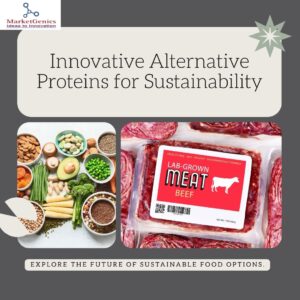With the growing demand for sustainable and nutritious food sources, alternative proteins are gaining significant attention all over the world. But people today don’t have to be restrictive to only plant-based protein, as more alternatives have entered the food market. In addition to plant-based proteins, other protein sources include fermented proteins, algae, insect protein, and cultured meat. Forecasts estimate that the alternative protein market value will reach 22.95 billion U.S. dollars by 2024, with a compound annual growth rate (CAGR) of 14.1% from 2025 to 2030.

If we look at history, insects have been consumed for centuries in various cultures around the world. They are an excellent source of protein, containing all essential amino acids, and are rich in vitamins and minerals. In comparison to conventional livestock, insects are a sustainable source of protein that use a lot less feed, water, and land, according to the Food and Agriculture Organisation (FAO).
Entomo Farms: it is one of the major producers of cricket and mealworm protein. This Canadian company focuses on pet food, sustainable human food and animal nutrition.
Protix Biosystems: Protix is a Dutch company popular for exploring various insect-based products. They specialise in marketing chicken eggs and salmon fed.
Insects are more sustainable. They require fewer resources such as food, water, land and energy than conventional animal agriculture.
The nutritional value in insects such as crickets and mealworms is up to 80% higher than others.
Insect protein has benefits, yet it is filled with challenges too. In many nations, including India, eating insects is frowned upon. Also, lack of regulatory frameworks in some regions can hinder the commercialization of edible insects.
Cultivated meat is meat produced directly from cells. The process of cultivating meat uses the basic elements needed to build muscle and fat and enables the same biological process that happens inside an animal. At the cellular level, farmed meat is the same as cultivated meat. This innovative approach aims to replicate the taste and texture of traditional meat while addressing ethical and environmental concerns.
The first cultivated burger was unveiled in August 2013 by Mark Post and his colleagues at Maastricht University. In 2016, UPSIDE Foods, the first cultivated meat company, was launched publicly.
Impossible Foods: This food company is popular for its innovative use of the Heme molecule. It completely mimics the aroma and flavour of cooked meat. Their products are ethical, sustainable and environmentally friendly.
Beyond Meat: Beyond Meat is a pioneer in lab-grown meat production. Their products replicate the taste and texture of animal meat in burgers, sausages, etc.
Mosa Meat: This Dutch food company is based in the Netherlands and very popular for producing lab-grown meat. They are into producing cultured beef products by growing meat from animal cells.
Cell based meat can significantly lower greenhouse gas emissions, land use, and water consumption compared to conventional meat production.
By eliminating animal suffering associated with livestock farming, cell-based meat appeals to ethically conscious consumers.
The only drawback with lab grown meat is the cost of production as it uses advanced technology and expensive culture media.
Mycoproteins are nothing but fermentation. It is derived from the fungus Fusarium venenatum. Ancient civilisations in India and other parts used microbial cultures to create alcoholic beverages and improve the nutritional value and bioavailability of foods ranging from yogurt to tempeh. Fermentation has a much wider range of uses now than it did in the past century.
Perfect Day: It is a dairy protein company that uses fermentation technology to create animal-free dairy products. Its products are sustainable and environmentally friendly.
Mycoproteins are low in saturated fats and high in fibre as well as protein. They also provide essential amino acids and micronutrients.
The fermentation process used to produce mycoproteins is easy and efficient, requiring less land and water compared to other processes.
Mycoproteins are popular, but still, some people may be allergic to mycoproteins, reducing its wide usage.
With the growing demand and awareness among people, alternate sources of protein have become popular. They are effective and fulfil most consumer demands, but they are costly. Advanced research to improve biotechnology needs to be done to reduce the cost. As we move forward, fostering a greater understanding and acceptance of these innovative protein sources will be key to their success. With MarketGenics research reports further giving a clear picture of the advancement in technology and statistics, a food company producing alternate protein can grow exponentially.


MarketGenics India is a MRSI certified company.
Send us your resume at
info@marketgenics.co
© 2025 MarketGenics India Pvt Ltd.; All rights reserved